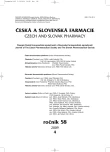Determination of the constituents of propolis of different geographical origin
Authors:
J. Muselík 1; R. Masteiková 1; V. Suchý 2; Z. Chalupová 1; V. Ostrá 1
Authors place of work:
Veterinární a farmaceutická univerzita Brno, Farmaceutická fakulta, Ústav technologie léků
1; Veterinární a farmaceutická univerzita Brno, Farmaceutická fakulta, Ústav přírodních léčiv
2
Published in the journal:
Čes. slov. Farm., 2009; 58, 179-183
Category:
Původní práce
Summary
The structural diversity of propolis constituents, due to a larger number of plant sources, is the cause of diverse composition and the hitherto unsolved standardization. The principal share in the biological effects is ascribed to flavonoids and aromatic acids and their derivatives. The results presented in this paper illustrate the diversity of the compositions of ten propolis samples obtained from different regions of the Czech Republic and three samples from abroad. Attention was paid to the determination of polyphenols, content of flavones and flavonols and the assay of antioxidative activity. The results confirmed the variability of the parameters under study as well as the presence of chrysin, galangin, p-coumaric, ferulic, cinnamic and benzoic acids in dependence on the area of collection. It will be difficult to elaborate a method of standardization suitable for possible administration of propolis preparations. In the future, propolis could become a raw material for the isolation of individual groups of biologically active substances.
Key words:
propolis – flavonoids – phenolic acids – antioxidative activity – liquid chromatography
Zdroje
1. Banskota, A. H., Tezuka, Y., Kadota, S.: Phytother. Res., 2001; 15, 561–571.
2. Lu, L. C., Chen, Y. W., Chou, C. C.: Int. J. Food Microbiol., 2005; 102, 213–220.
3. Borrelli, F. et al.: Fitoterapia, 2002; 73 Suppl. 1, 53–63.
4. Sawaya, A. C. H. F. et al.: Lett. Appl. Microbiol., 2002; 35, 203–207.
5. Moreira, L. et al.: Food Chem. Toxicol., 2008; 46, 3482–3485.
6. Sforcin, J. M.: J. Ethnopharmacol., 2007; 113, 1–14.
7. Banskota, A. H. et al.: Phytomedicine, 2001; 8, 16–23.
8. Gekker, G. et al.: J. Ethnopharmacol., 2005; 102, 158–163.
9. Lucrecia, L. et al.: Food Sci. Technol., 2009; 42 1422–1427.
10. Hegyi, E., Suchý, V., Nagy, M.: Hautarzt, 1990; 41, 675–679.
11. Hausen, B. M. et al.: Contact Dermatitis, 1987; 17, 163–170.
12. Hausen, B. M. et al.: Contact Dermatitis, 1987; 17, 171–177.
13. Bankova, V.: J. Ethnopharmacol., 2005; 100, 114–117.
14. Šmejkal, K. et al.: Molecules, 2007; 12, 1210–1219.
15. Trusheva, B., Trunkova, D., Bankova, V.: Chem. Cent. J., 2007; 1, 1–4.
Štítky
Farmácia FarmakológiaČlánok vyšiel v časopise
Česká a slovenská farmacie

2009 Číslo 4
Najčítanejšie v tomto čísle
- Standardní receptura pro přípravu léčivých přípravků v lékárnách III Některé možnosti využití isopropylalkoholu
- Stanovení obsahových látek propolisů různého geografického původu
- Studium vlastností tablet z přímo lisovatelného isomaltu
- Určení tloušťky obalu tvrdých hypromelosových tobolek pomocí blízké infračervené spektroskopie
